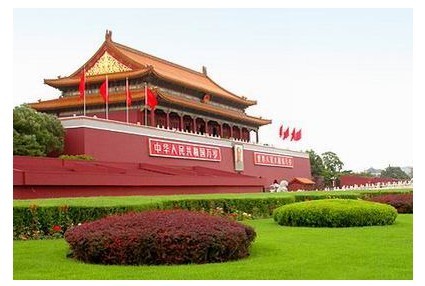Tiananmen Square In Beijing
 Tiananmen Square is the largest downtown square in the world. It covers an area of 44 hectares, big enough to hold one million people. From the red wall of the Tian'anmen Rostrum in the north to the south gate, it measures some 880 meters, and from the Museum of Chinese Revolution and Chinese History in the east to the Great Hall of the People in the west, it is about 500 meters.
Tiananmen Square is the largest downtown square in the world. It covers an area of 44 hectares, big enough to hold one million people. From the red wall of the Tian'anmen Rostrum in the north to the south gate, it measures some 880 meters, and from the Museum of Chinese Revolution and Chinese History in the east to the Great Hall of the People in the west, it is about 500 meters.
Now Tiananmen Square is one of the most famous and popular places in China. It is the place for celebrations on such festive days as International Labor Day on May 1 and National Day on October 1.
History
The gate was originally named Chengtianmen or "Gate of Accepting Heavenly Mandate", and it has been destroyed and rebuilt several times. The original building was first constructed in 1420 as an exact replica of a gate in the form of paifang of the imperial building in Nanjing with the same name and hence inherited the name Chentianmen. The gate was damaged by lightning in July, 1457, and was completely burnt down. In 1465, Chenghua Emperor ordered Zi Gui , the minister of Engineering Ministry to rebuild the gate, and the design was changed from the original paifang form to the gatehouse that is seen today. It suffered another blow in the war at the end of Ming Dynasty - in 1644 the gate was burnt down by rebels led by Li Zicheng. Following the establishment of the Qing Dynasty and the Manchu conquest of China proper, the gate was once again begun to be rebuilt in 1645 and was given its present name in 1651 when the construction completed six years later. The Tiananmen gate was reconstructed again between 1969-1970. The gate as it stood was by then 500 years old, and had badly deteriorated, partly due to heavy usage in the 1950s-60s. As the gate was a national symbol, then-Premier Zhou Enlai ordered that the rebuilding was to be kept secret. The whole gate was covered in scaffolding, and the project was officially called a "renovation". The rebuilding aimed to leave the gate's external appearance unchanged while making it more resistant to earthquakes and featuring modern facilities such as an elevator, water supply and heating system.



